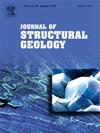各种多矿物岩石和砂浆的方解石双应力应变指标
IF 2.6
2区 地球科学
Q2 GEOSCIENCES, MULTIDISCIPLINARY
引用次数: 0
摘要
本文提出了各种多矿物材料在低温弹性条件下的应变和应力估算公式。Sakaguchi et al.(2011)基于离散元法模拟和弹性变形范围内的三轴压缩试验,提出平均孪晶片密度(Dtw)(孪晶数/mm)取决于影响整个试样的载荷。然而,他们推导出的应力与Dtw的关系公式仅基于日本西南部Shimanto沉积杂岩的硬砂岩,仅适用于杨氏模量相似的岩石。本研究试图对掺入合成方解石颗粒的砂浆试样进行单轴压缩试验。采用高强度水泥,通过改变水灰比,可以得到杨氏模量在5.9 ~ 10gpa之间的试样。在高压灭菌器中合成的方解石不含原生孪晶片。从单轴压缩试验结果来看,Dtw由0增加到212/mm。Dtw取决于影响整个样本的负载。不同杨氏模量试件的Dtw随荷载的增加速率不同,但无论杨氏模量如何,所有试件的Dtw都与应变成正比,其表达式为:ε= 0.0094Dtw-0.20(±0.105),其中ε为缩短应变(%)。对于没有塑性变形且已知杨氏模量的硬试样,由于弹性应变和应力成正比,故试样所经历的古应力可以由平均Dtw得到的应变来估计。该技术可用于从构造地质到建筑施工的低温和弹性应变状态问题。本文章由计算机程序翻译,如有差异,请以英文原文为准。
Calcite twin stress and strain indicators for various polymineralic rocks and mortars
This paper proposes new formula to estimate strain and stress of various polymineralic materials in low-temperature elastic condition. Sakaguchi et al. (2011) proposed that the average twin lamellae density (Dtw) (number of twins/mm) depends on the load affecting the entire sample, based on discrete element method simulations and triaxial compression tests in the elastic deformation range. However, their derived relational formula between stress and Dtw, based solely on hard sandstone from the Shimanto accretionary complex in SW Japan, is only applicable to rocks with similar Young's modulus. This study attempted to perform uniaxial compression tests on mortar samples mixed with synthetic calcite grains. The specimens with different Young's modulus from approximately 5.9 to 10 GPa can be made by varying the water/cement ratio using the high strength cement. Calcite synthesized in an autoclave does not contain primary twin lamellae. From the result of the uniaxial compression test, the Dtw increased from 0 to 212/mm. The Dtw depends on the load affecting the entire sample. The rate of increase of Dtw with load varies for specimens with different Young's modulus, but Dtw increases in direct proportion to strain for all specimens regardless of Young's modulus, as represented by:
where, ε represents shortening strain (%). For a hard specimen without plastic deformation and with a known Young's modulus, the paleo-stress experienced by the specimen can be estimated from the strain obtained from the average Dtw, since elastic strain and stress are proportional. This technique can be used for problems ranging from structural geology to building construction ones at low temperature and elastic strain state.
求助全文
通过发布文献求助,成功后即可免费获取论文全文。
去求助
来源期刊

Journal of Structural Geology
地学-地球科学综合
CiteScore
6.00
自引率
19.40%
发文量
192
审稿时长
15.7 weeks
期刊介绍:
The Journal of Structural Geology publishes process-oriented investigations about structural geology using appropriate combinations of analog and digital field data, seismic reflection data, satellite-derived data, geometric analysis, kinematic analysis, laboratory experiments, computer visualizations, and analogue or numerical modelling on all scales. Contributions are encouraged to draw perspectives from rheology, rock mechanics, geophysics,metamorphism, sedimentology, petroleum geology, economic geology, geodynamics, planetary geology, tectonics and neotectonics to provide a more powerful understanding of deformation processes and systems. Given the visual nature of the discipline, supplementary materials that portray the data and analysis in 3-D or quasi 3-D manners, including the use of videos, and/or graphical abstracts can significantly strengthen the impact of contributions.
 求助内容:
求助内容: 应助结果提醒方式:
应助结果提醒方式:


